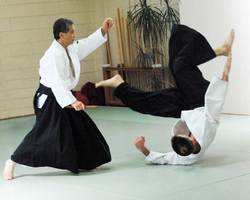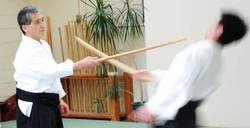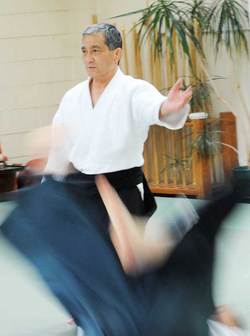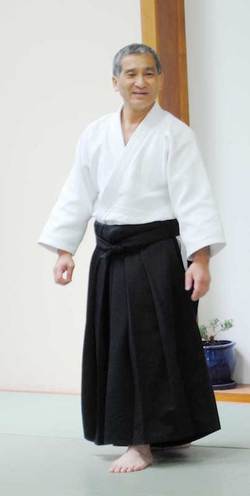About Shiohira Sensei
Shiohira Sensei is 7th dan Shihan from Aikikai Hombu Dojo, Tokyo, Japan. He is Chief Instructor for the Pacific Aikido Federation and is currently one of a few representatives of Hombu Dojo in the US.
Shiohira Sensei teaches classes six days a week at his home dojos in Mountain View and San Francisco. He also conducts monthly black belt seminars and aikido camps twice a year. Shiohira Sensei leads monthly zazenkai (zen training) sessions at the Mountain View dojo.
Shiohira Sensei's Training Approach
Shiohira Sensei believes the Aikido techniques themselves are the philosophy of Aikido. His approach is to directly train and learn the techniques and basic movements. This does not mean learning the thousands of techniques in Aikido, but rather getting the correct feelings and mechanics of the basic Aikido movements and then applying them to the techniques. Ma'ai (distance and timing) and Ki are important aspects of this approach as well as a stability of being.
He believes that too much thinking, talking and philosophizing with the intellect does not help this happen and just leads to a hot head and a lot of agitation that dulls awareness. The emphasis is on moving from the hara, with correct breath and posture.
Shiohira Sensei's Background
 Shiohira Sensei began studying Aikido at Waseda University Aikikai under Shizuo Imaizumi Sensei in the spring of 1967. He also trained at Hombu Dojo and he had one year of live-in training under the second Doshu, Kisshomaru Ueshiba Sensei. He also received instruction from all of the other leading Aikido World Headquarters instructors at the time, including O-Sensei (Founder), Kisshomaru Ueshiba Sensei (Second Doshu), Koichi Tohei Sensei (Chief Instructor), Kisaburo Osawa Sensei, Morihiro Saito Sensei, Seigo Yamaguchi Sensei, Sadateru Arikawa Sensei and, at Shingu, Michio Hikitsuchi Sensei. He studied Shin Shin Toitsu Aikido under Koichi Tohei Sensei (Founder) for over twenty years. He also studied under Hiroshi Tada Sensei after rejoining Aikikai in 1994.
Shiohira Sensei began studying Aikido at Waseda University Aikikai under Shizuo Imaizumi Sensei in the spring of 1967. He also trained at Hombu Dojo and he had one year of live-in training under the second Doshu, Kisshomaru Ueshiba Sensei. He also received instruction from all of the other leading Aikido World Headquarters instructors at the time, including O-Sensei (Founder), Kisshomaru Ueshiba Sensei (Second Doshu), Koichi Tohei Sensei (Chief Instructor), Kisaburo Osawa Sensei, Morihiro Saito Sensei, Seigo Yamaguchi Sensei, Sadateru Arikawa Sensei and, at Shingu, Michio Hikitsuchi Sensei. He studied Shin Shin Toitsu Aikido under Koichi Tohei Sensei (Founder) for over twenty years. He also studied under Hiroshi Tada Sensei after rejoining Aikikai in 1994.
In addition to Aikido training and instruction, he studied Zen under Zen and martial arts master Tenshin Tanouye Rotaishi. He trained in Misogi Shugyo at the Ichikukai Dojo under Tesso Hino Sensei.
Shiohira Sensei has been training and teaching Aikido as THE WAY. Several of his students have become Aikido Masters or Zen Masters, and several more advanced ones just continue training. He wants to maintain a dojo where one can be free from distractions, to see things as they truly are to live well.
Shiohira Sensei's Aikido Philosophy
Aikido and Self-Defense
Some people join the school to gain confidence in a fighting situation. They have to realize that knowing self-defense techniques and being confident are not necessarily the same. Techniques belong to physical training and confidence to philosophical and mental training. This suggests that you train with breathing exercises and meditation as well as Aikido techniques. In the end the best self-defense for you is knowing techniques and keeping yourself alert and calm.
The Deeper Way of Aikido
 Aikido is one of the East Asian ways of training that tries to lead us to find our true selves and helps us remain undisturbed by the dualism of win or lose, good or bad, by going beyond them. This guides us toward Absolute Peace even in the midst of turmoil.
Aikido is one of the East Asian ways of training that tries to lead us to find our true selves and helps us remain undisturbed by the dualism of win or lose, good or bad, by going beyond them. This guides us toward Absolute Peace even in the midst of turmoil.
There are roughly three stages in martial arts training. First, you practice the physical art over and over. Second, you make the physical art a part of yourself by coordinating mind and body. Last, you use this coordination to find your true self.
There needs to be a jump to go from the second to the last stage. In Japan it was the tradition for many martial artists to take Zen to link these two stages to complete training in a martial art. In Japanese this kind of training is called shugyo. Shugyo means not only being good at an art but also making an effort to find out your true self, and to be able to live accordingly. This shows the clear difference between martial arts and sports.
Shugyo teaches us to commit every moment of our lives. If we commit every moment of our lives we will be a "Total Being" in every situation. When it's time to eat we eat; to work, we work; to be nice, we become nice. This will make us clear-minded and will make others feel clear with us. This is nothing special or spectacular but is the common and most fulfilling way. It sounds easy, but is the most difficult to do. To be a person like this we have through Shugyo to get rid of the attachment to our ego.
Practical Translations of Aikido and Related Philosophies
 - Aikido is a non-aggressive martial art. We can be non-aggressive in a martial arts situation by maintaining coordination of mind and body and keeping ourself together without being subdued by an attacker.
- Aikido is a non-aggressive martial art. We can be non-aggressive in a martial arts situation by maintaining coordination of mind and body and keeping ourself together without being subdued by an attacker.
- The proper distance from an opponent is called ma'ai. It is important to keep ma'ai, because an opponent has to make at least two motions to attack as long as we maintain ma'ai: first, approach; second, attack. We can respond as soon as we see the first motion if we have ourself together. The ma'ai sense can also be applied in our daily human interactions.
- Energy called ki pours out of us when we are together and grounded. Ki will seal all openings ("suki") from an opponent's attack.
- Martial arts motions all begin from two to three inches below the navel, traditionally called hara, by moving from the torso, and legs and feet.
- Traditionally we emphasize coordination of mind and body. "No mind" does not mean "absent mind". The mind is free, and mind and body are functioning at their best when we are not attached. The brain controls us when we are attached, we cannot function fully and are not integrated. The brain is part of our existence: We use our brain, but should not let a part of us control our whole existence. As an example of "we use our brain", we cannot respond when attacked if we consider optional responses, whether "good or bad, intelligent or unintelligent". All of you, including the brain, has to respond to an attack.
- We think when we think, we do when we do. Fulfillment comes when we are not attached or stuck mentally. The Aikido experience embodies "I am, therefore I think", rather than "I think, therefore I am". Body and mind are originally one.
- We have to relax instead of becoming tense. Tenseness contributes nothing to force. Physics says that force derives from mass and speed. We become slower when we are tense. Tenseness reduces our force.
- The martial arts train breath and posture in addition to learning techniques. Breath and posture training continue throughout our lives even after completing training in techniques. Posture and depth of the breath demonstrate the level of both training and of personal development.
- The purpose of martial arts is not necessarily winning, but rather not losing. This attitude potentially affects how to behave in any situation, and defines a crucial difference between martial arts and sports. Martial arts have a deeper meaning than sport. Particularly Japanese martial arts would be better defined as "martial way (of life)".

